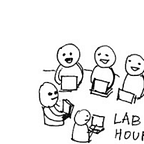blog post by Gia Castello & Esther Bouquet. video by Olivia Ross.
Day 1:
The week started after another busy weekend full of events. We went to Radical Networks to support Esther, one of the current students who was showing an installation at the event. We also went to Gowanus Open Studios and Westbeth Open Studios, both of which allow people to see artists work spaces and ask questions.
In Zach’s class, we reviewed Muriel Cooper’s artwork. We were impressed by her talks and quotes and as classwork, we collaboratively compiled her work in a document. We shared some of her images here for you to also enjoy.
We then had a lesson on vectors and learned about John Maeda’s work, who wrote the book Design by Numbers. His works provide a good example to illustrate how vectors are handy to build growable arrays to define shapes. In openFrameworks we utilized the properties of Ofpoint, Ofpolyline and Ofpath.
Day 2: Losing control by abstraction
The critical theory classes ‘Dark Matters’ with American and Tsige go deeper, and deeper. The more context we acquire, the more tools we have to re-think how we build technology. American started talking about the publication we are going to make with our ideas and texts and presented previous students works as references.
In this particular class, we reviewed the story of computation from 1940’s understanding of the post-WWII tech scene, when students began to practice entrepreneurial skills, and founded today’s startup culture. We learned that Xerox built the first personal computer Amiga which cost around $10,000 which was a very high price point thus inaccessible to most consumers. The Amiga however inspired Steve Jobs to build Apple Lisa, the first affordable personal computer.
We discussed the changes throughout the years on how we all interact with computers: from manually switching cables to connect circuits (like an old telephone operator), to using keyboards and mouses, and now, touchscreens. Through these changes, the more abstract tech becomes, the less we understand about it. After class, we had a long debate where we shared our thoughts on how we can make tech more comprehensible for users.
In the evening, a few of us went to see “Waterlicht”, an installation by Daan Roosegaarde at Columbia University. It was a delicious feast of sine waves.
Day 3: A family composed by CN4093 bugs
During the hardware class review this week, we realized that most of us didn’t really understand what transistors are and how to use logic gates. Taylor revisited lessons from the class she gave us last week, talking more about pull up and pull down resistors. These resistors are useful because electricity is floating in the circuit otherwise and can lead to unexpected behavior.
She also tried to simplify the use of logic gates and how to build them by showing us the NAND Schmitt Trigger CN4093. This little bug-looking chip is very helpful because it has built-in NAND gates, also known as universal gates, which can be used to build a NOT gate or an OR gate much easier then doing it from scratch.
Wednesday night we have family dinner, and Lauren cooked for us a delicious pozole.
Day 4: Peer to peer folder poetry
In Code Poetry class, we got intimate with computers with Melanie Hoff. We started our journey by learning Bash as tool for creating a poetry, to feel more comfortable sharing ideas on our computers. We discussed the importance of names and naming conventions, that by naming something, we acknowledge that they exist.
Our class exercise was to build a series of ‘rooms’ (out of folders and text files) using Bash and think about the architecture, the spaces it has, how it is laid out. We talked about centralized, decentralized and distributed networks, and debated about the importance of shared governance of networks.
In the afternoon, our classmate Yuzhu Chai gave a workshop about how to make Zines. We learned a little about the history of self publications, and designed our own. We learned 5 techniques to fold paper, and we also sewed our tiny creations.
Day 5: Showcase your core values
Lauren Gardner, one of the session organizers, gave a quick introduction to the student showcase we will be participating in at the end of the semester on December, 1st & 2nd. She encouraged us to think about our life goals and our values and if we have too many ideas on what to make, measure them against our goals and values to help decide which one to persue. She also recommended thinking about our pieces so far, their documentation, and the feelings we want to provoke.
After that she also told us to imagine these pieces as a work in progress for our next steps as an artist: where do we want to go, and how these pieces are going to help us to get closer to that path.
In the afternoon, Gia Castello gave a workshop about VR storytelling. We learned how to take 360 pictures and prototyped our own 360 stories. We also discussed about how to think stories when there are no frames, learned about different types of triggers to drive users’ attention and created a VR piece with GuriVR openSource tool that we could share and see on our smartphones.
See you in Week 5 next week!
